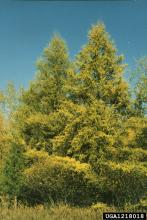Plant Groups
Related Biomes
Tamarack

Tamarack, Larex laricina, in Michigan. Credit: Bill Cook, Michigan State University, Bugwood.org
Larex laricina
Tamarack
Hackmatack
Eastern larch
Black larch
Red larch
American larch
Tamarack is a deciduous conifer with needle-like leaves that are shed in the fall. They are one of the most widely distributed native North American conifers and are commonly found in bogs, fens and swamps across southern Canada and the northern U.S. Midwest. This tree thrives on acidic, poorly drained soils and does not tolerate warmer climates or dry substrates. It is common in bogs, fens and swamps, where it grows rapidly under favorable conditions. In less favorable habitats, such as on dry mountain slopes or near the limits of its range, this tree is often stunted and much slower-growing.
Tamarack typically grows to heights of 40-80 feet, and occasionally up to 100 feet. It has a straight trunk with a diameter of roughly 1.5 feet, and a narrow, conical crown. This tree has thin, scaly, reddish to grayish brown bark and oblong, 0.5-1 inch long, reddish-brown cones with stiff, rounded scales. Its most distinguishing feature is its deciduous needles, which are clustered in spirals and appear to be small tufts of needles along the twig. Needles are light green at the beginning of the growing season, become darker green later in the season, and turn golden in the autumn before they are shed. Tamarack is not an important food resource for larger animals, but snowshoe hares and porcupine consume the twigs and bark, and mice, shrews, voles will eat the seeds. Caribou may consume small amounts of tamarack, while other large ungulates avoid the tree all together.
Related Plants:








